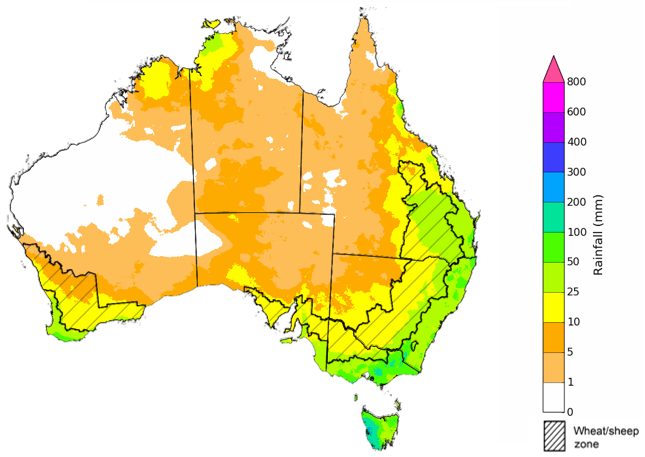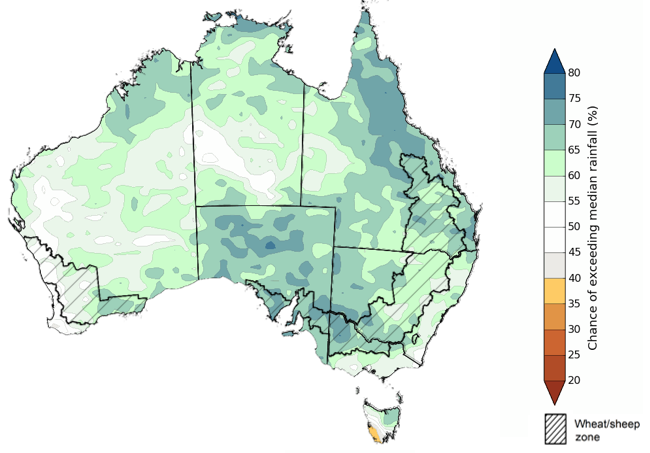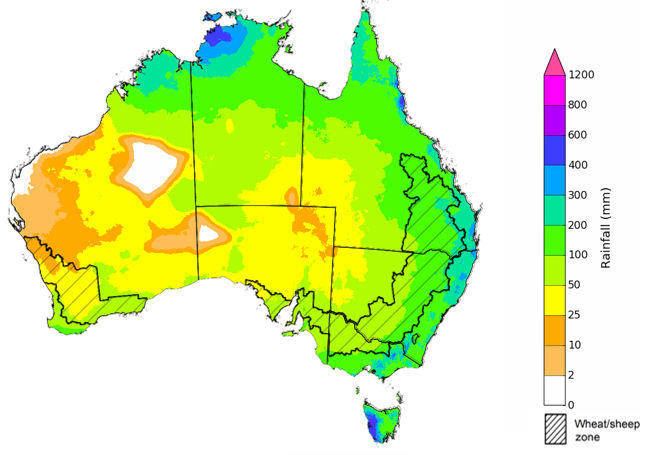Key issues
- In the week ending 25 September 2024, a series of cold fronts and low-pressure systems brought rainfall to large areas of north-western and parts of south-eastern Australia, with other areas largely dry.
- Across cropping regions, little to no rainfall was recorded across most areas this week.
- In areas where stored soil moisture has declined to low levels across parts of south-eastern and south-western Australia, little to no rainfall has likely lead to reduced yield potential, exacerbated by severe frosts and windy conditions across some areas in recent weeks.
- Over coming days, low-pressure and frontal systems are expected to interact with humid unstable air masses to bring showers and storms to western, eastern and southern Australia. High-pressure systems are expected to keep remaining areas largely dry.
- Across cropping regions, widespread rainfall is expected in most areas. Rainfall totals of between 5 and 25 millimetres are expected in Queensland, Victoria and South Australia, with falls of between 5 and 50 millimetres expected in New South Wales and Western Australia.
- If realised, these falls may be sufficient to boost soil moisture levels and stabilise winter crop yields across most growing regions. However, in parts of south-eastern and south-western Australia these falls may arrive too late to prevent crop yields falling below those expected at the end of August, following very dry conditions during September-to-date and recent severe frost events.
- The national rainfall outlook for October to December is a high probability of above median rainfall across much of the country.
- Across most cropping regions there is a 50% or greater chance of receiving above median rainfall. Higher than average rainfall is expected in Queensland, southern New South Wales, Victoria and South Australia.
- There is 75% chance of rainfall totals being between 50 to 200 millimetres across most cropping regions, with higher rainfall expected in Queensland. If realised, these expected rainfall totals will likely provide a boost soil moisture profile and assist in maintaining current winter crop yield expectations in most regions and provide a favourable start to the summer cropping season across eastern Australia.
- Water storage levels in the Murray-Darling Basin (MDB) decreased between 19 September 2024 and 26 September 2024 by 214 gigalitres (GL). Current volume of water held in storage is 17,927 GL, equivalent to 81% of total storage capacity. This is 12 percent or 2,814 GL less than at the same time last year.
- Allocation prices in the Victorian Murray below the Barmah Choke increased from $145/ML (Megalitre) on the 19 September 2024 to $147/ML on the 26 September 2024. Prices are lower in the Murrumbidgee due to the binding of the Murrumbidgee export limit.
Climate
For the week ending 25 September 2024, a series of cold fronts moved through south-eastern Australia, bringing showers and isolated thunderstorms. Meanwhile, an upper-level trough, combined with tropical moisture, triggered several days of widespread rainfall and isolated thunderstorms across the north of Western Australia and western parts of the Northern Territory. Rainfall totals of up to 50 millimetres were recorded across parts of southern New South Wales, Victoria and South Australia. Heavier fall of up to 150 millimetres were recorded across large areas of northern Western Australia and the west of the Northen Territory. In Tasmania, cold fronts brought rainfall totals of up to 150 millimetres in the west. High pressure systems saw much of the remainder of the country record little to no rainfall.
Across cropping regions, little to no rainfall was recorded across most areas this week. Isolated areas of southern New South Wales, Victoria, South Australia and southern Western Australia recorded rainfall totals of between 1 and 10 millimetres. Little to no rainfall across most cropping regions has likely contributed to a drawdown of stored soil moisture. Where average levels of stored soil moisture are available, crops and pastures would have been able to draw on these reserves to maintain current yield potentials. However, in areas where stored soil moisture levels are low, little to no rainfall is likely to lead to reduced yield potential, exacerbated by severe frosts and windy conditions across some areas in recent weeks.
Rainfall for the week ending 25 September 2024

Issued: 25/09/2024
Note: The rainfall analyses and associated maps utilise data contained in the Bureau of Meteorology climate database, the Australian Data Archive for Meteorology (ADAM). The analyses are initially produced automatically from real-time data with limited quality control. They are intended to provide a general overview of rainfall across Australia as quickly as possible after the observations are received. For further information go to http://www.bom.gov.au/climate/rainfall/
Over the 8 days to 3 October 2024, low-pressure and frontal systems are expected to interact with humid unstable air masses to bring showers and storms over western, southern and eastern parts of the country. Up to 50 millimetres is forecast for much of Western Australia and Tasmania, with falls of between 5 and 25 millimetres expected across Victoria, south-eastern Queensland, much of South Australia, and parts of eastern Northern Territory. Rainfall totals of between 5 and 100 millimetres are forecast for New South Wales. High pressure systems are expected to keep much of north-eastern and central Australia largely dry.
Across cropping regions, widespread rainfall is expected in most areas. Rainfall totals of between 5 and 25 millimetres are expected in Queensland, Victoria and South Australia, with falls of between 5 and 50 millimetres expected in New South Wales and Western Australia.
If realised, these falls may be sufficient to boost soil moisture levels and stabilise winter crop yields across most growing regions. However, in parts of south-eastern and south-western Australia these falls may arrive too late to prevent crop yields falling below those expected at the end of August, following very dry conditions during September-to-date and recent severe frost events.
Total forecast rainfall for the period 26 September to 3 October 2024

Issued 26/09/2024
Note: This rainfall forecast is produced from computer models. As the model outputs are not altered by weather forecasters, it is important to check local forecasts and warnings issued by the Bureau of Meteorology.
The El Niño Southern Oscillation (ENSO) and Indian Ocean Dipole (IOD) climate drivers are currently neutral and having minimal influence on Australian rainfall. The Southern Annular Mode (SAM) has been positive for several weeks (as at 15 September). Forecasts indicate it is likely to become neutral over the coming week. A neutral SAM has no strong relationship to forecast climate conditions.
The most recent rainfall outlook for October 2024 provided by the Bureau of Meteorology indicates that much of New South Wales, Queensland, Victoria, South Australia and western areas of Western Australia is likely to see above median rainfall (between 55 to 75% chance). There is a roughly equal probability of either above or below median rainfall across large areas of central and northern Australia.
According to Bureau of Meteorology’s climate model, for October 2024, there is a 75% probability of rainfall totals of between 10 and 50 millimetres across much of eastern and southern New South Wales, eastern Queensland, the far south-west of Western Australia, southern agricultural areas of South Australia, and scattered areas of the tropical north. Meanwhile, Tasmania and Victoria are expected to see falls of between 10 and 200 millimetres. Much of northern, western and central Australia is expected to receive little to no rainfall. This is consistent with the Bureau of Meteorology’s forecast of a delayed northern rainfall onset.
Across cropping regions, there is a 75% chance of receiving between 10 and 50 millimetres of rainfall across much of Queensland, New South Wales, South Australia and Victoria, with higher rainfall totals expected in eastern regions. In Western Australia, rainfall totals are expected to be between 5 and 25 millimetres. These rainfall totals, if realised, are likely to be sufficient to support above average yield prospects of winter crops in regions with ample sub-soil moisture reserves. However, in areas with limited stored soil moisture or have suffered yield downgrades due to severe frost and dryness during September, these falls are likely to only be sufficient to maintain these downgraded yield expectations.
Rainfall totals that have a 75% chance of occurring in October 2024

Issued: 26/09/2024
The rainfall outlook for October to December 2024 indicates an increased probability of above average rainfall across much of the country. In contrast, below median rainfall is more likely across isolated areas of south-western Tasmania.
Across cropping regions, the probability of receiving median rainfall is between 50% and 70% in Queensland, New South Wales and Western Australia. In Victoria and South Australia, the probability of above median rainfall is between 65% to 75%. If above median rainfall is realised, this rainfall is likely to support the storage of soil moisture in eastern regions for the summer cropping period and contribute to improving soil moisture in southern regions.
Chance of exceeding the median rainfall October to December 2024

Issued: 26/09/2024
The outlook for October through to December suggests a 75% chance of rainfall totals between 50 and 300 millimetres across much of New South Wales, Queensland, Victoria, Tasmania and the Northern Territory, and across parts of South Australia and Western Australia. Rainfall totals in excess of 300 millimetres are forecast for alpine regions of Victoria and New South Wales, isolated coastal areas of eastern New South Wales and Queensland, western Tasmania and the tropical north of the Northern Territory.
In cropping regions, there is a 75% chance of receiving between 100 and 300 millimetres of rainfall across much of Queensland, and between 50 and 200 millimetres across New South Wales and Victoria. Conditions are expected to be drier in Western Australia and South Australia, with forecast rainfall to between 10 and 100 millimetres, and 25 to 100 millimetres, respectively.
If realised, these expected rainfall totals are likely to be sufficient to support the growth and development of winter crops, boost soil moisture profile and assist in maintaining current winter crop yield expectations in most regions and provide a favourable start to the summer cropping season across eastern Australia. However, a potential downside production risk still remains across isolated regions across southern Australia exhibiting extremely low soil moisture levels leading into October.
Livestock producers, especially those in the southeast, east and far north, are expected to experience improved pasture production given this favourable rainfall outlook over the October to December period.
Rainfall totals that have a 75% chance of occurring October to December 2024

Issued: 26/09/2024
Water
Water storages, water markets and water allocations - current week
The Tableau dashboard may not meet accessibility requirements. For information about the contents of these dashboards contact ABARES.
Commodities
Information on weekly price changes in agricultural commodities is now available at the Weekly commodity price update.
